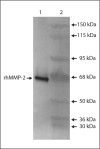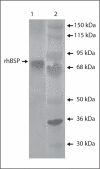Increased matrix metalloproteinase-2 and bone sialoprotein response to human coronal caries
- PMID: 21876355
- PMCID: PMC3182042
- DOI: 10.1159/000330601
Increased matrix metalloproteinase-2 and bone sialoprotein response to human coronal caries
Abstract
Background: It has been suggested that host matrix metalloproteinase-2 (MMP-2) present in dentin may be involved in caries progression, however, its response to caries is not known. Bone sialoprotein (BSP) has been implicated in dentin mineralization and MMP-2 modulation.
Objective: To identify and compare the distribution of MMP-2 and BSP in healthy human coronal dentin and those with early caries.
Methods: Freshly extracted 3rd molars and premolars with and without early caries were fixed, demineralized and subjected to immunohistochemistry using a monoclonal anti-MMP-2 antibody and monoclonal anti-BSP antibody with an avidin-biotin complex method. Immunoreactivity was visualized with 3,3'-diaminobenzidine substrate and observed under light microscopy.
Results: Immunohistochemical analysis revealed that MMP-2 and BSP are not detected in the tubule lumens of healthy dentin. However, intense immunoreactivity for MMP-2 and BSP was detected in association with the full length of the caries-affected dentinal tubules. The MMP-2 and BSP at the dentino-enamel junction appeared unaltered.
Conclusion: The results indicate that MMP-2 and BSP may be actively secreted by odontoblasts in response to carious insult. MMP-2 and BSP accumulation in the caries-affected dentinal tubules may indicate their potential involvement in the host defense mechanism which results in calcification of regions affected by the carious process.
Copyright © 2011 S. Karger AG, Basel.
Figures










Similar articles
-
Bone sialoprotein, matrix metalloproteinases and type I collagen expression after sealing infected caries dentin in primary teeth.Caries Res. 2014;48(4):312-9. doi: 10.1159/000355302. Caries Res. 2014. PMID: 24556583
-
The localization of matrix metalloproteinase-20 (MMP-20, enamelysin) in mature human teeth.J Dent Res. 2002 Sep;81(9):603-7. doi: 10.1177/154405910208100905. J Dent Res. 2002. PMID: 12202640
-
Differential expression of matrix metalloproteinase-2 in human coronal and radicular sound and carious dentine.J Dent. 2010 Aug;38(8):635-40. doi: 10.1016/j.jdent.2010.05.001. Epub 2010 May 7. J Dent. 2010. PMID: 20452393
-
Structural events in the caries process in enamel, cementum, and dentin.J Dent Res. 1990 Feb;69 Spec No:559-66; discussion 634-6. doi: 10.1177/00220345900690S112. J Dent Res. 1990. PMID: 2179314 Review.
-
Dentin caries progression and the role of metalloproteinases: an update.Eur J Paediatr Dent. 2016 Sep;17(3):243-247. Eur J Paediatr Dent. 2016. PMID: 27759416 Review.
Cited by
-
Distinctive role of ACVR1 in dentin formation: requirement for dentin thickness in molars and prevention of osteodentin formation in incisors of mice.J Mol Histol. 2019 Feb;50(1):43-61. doi: 10.1007/s10735-018-9806-z. Epub 2018 Dec 5. J Mol Histol. 2019. PMID: 30519900
-
Presence of host and bacterial-derived collagenolytic proteases in carious dentin: a systematic review of ex vivo studies.Front Cell Infect Microbiol. 2023 Oct 31;13:1278754. doi: 10.3389/fcimb.2023.1278754. eCollection 2023. Front Cell Infect Microbiol. 2023. PMID: 38029242 Free PMC article.
-
Dentin Degradation: From Tissue Breakdown to Possibilities for Therapeutic Intervention.Curr Oral Health Rep. 2023 Sep;10(3):99-110. doi: 10.1007/s40496-023-00341-4. Epub 2023 Jul 25. Curr Oral Health Rep. 2023. PMID: 37928132 Free PMC article.
-
Role of dentin MMPs in caries progression and bond stability.J Dent Res. 2015 Feb;94(2):241-51. doi: 10.1177/0022034514562833. Epub 2014 Dec 22. J Dent Res. 2015. PMID: 25535202 Free PMC article. Review.
-
Deep Saliva Proteomics Elucidating the Pathogenesis of Early Childhood Caries and Identifying Biomarkers for Early Prediction.J Proteome Res. 2025 Feb 7;24(2):750-761. doi: 10.1021/acs.jproteome.4c00831. Epub 2024 Dec 16. J Proteome Res. 2025. PMID: 39681551 Free PMC article.
References
-
- Arnold WH, Konopka S, Gaengler P. Qualitative and quantitative assessment of intratubular dentin formation in human natural carious lesions. Calcif Tissue Int. 2001;69:268–273. - PubMed
-
- Arnold WH, Konopka S, Kriwalsky MS, Gaengler P. Morphological analysis and chemical content of natural dentin carious lesion zones. Ann Anat. 2003;185:419–424. - PubMed
-
- Baht GS, Hunter GK, Goldberg HA. Bone sialoprotein-collagen interaction promotes hydroxyapatite nucleation. Matrix Biol. 2008;27:600–608. - PubMed
-
- Boukpessi T, Menashi S, Camoin L, Ten Cate JM, Goldberg M, Chaussain-Miller C. The effect of stromelysin-1 (MMP-3) on non-collagenous extracellular matrix proteins of demineralized dentin and the adhesive properties of restorative resins. Biomaterials. 2008;29:4367–4373. - PubMed
Publication types
MeSH terms
Substances
Grants and funding
LinkOut - more resources
Full Text Sources
Medical
Miscellaneous

